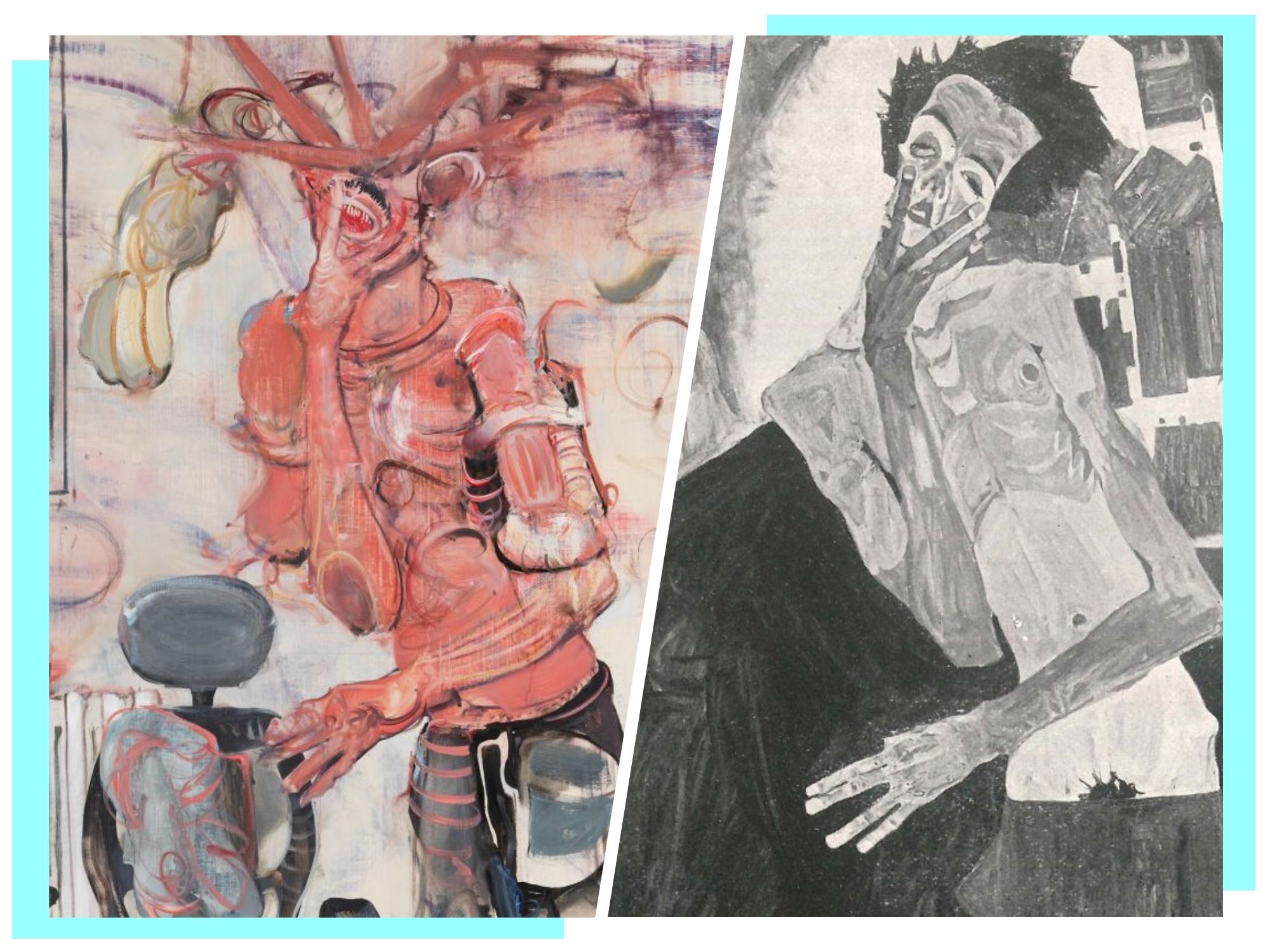
Lost artworks exert an almost ghostly power over the art historical imagination. One need only call to mind the dramatically empty frames hanging in the Isabella Stewart Gardner Museum or the penetrating gaze of lost Raphael’s Portrait of a Young Man, known today only through reproduction, to have a sense of this spectral power.
Adrian Ghenie, Auferstehung (2024). Courtesy of Infinitart Foundation.
Now, an evocative new exhibition “Adrian Ghenie—Shadow Paintings” at the Albertina in Vienna, dives deep into the psychological complexities of lost art (on view through March 2, 2025). For the exhibition, the Romanian painter Adrian Ghenie offers his visceral, often brutal responses to three lost masterworks by Austrian Expressionist Egon Schiele, works known as his “shadow paintings.” All three paintings are double self-portraits by the artist, which went missing during World War II and have remained missing for nearly 80 years. These paintings are now only known through grainy black-and-white photographs reproduced in a 1911 publication. Still, the might of these paintings has been powerful through their very absence, which Ghenie here examined.
The genesis for this exhibition was conceived by the collector and philanthropist Ciprian Adrian Barsan, who is known as C.A.B. The collector was moved by Ghenie’s masterpiece The Crucifixion on view at the Chiesa della Madonna della Mazza in Palermo and proposed the exhibition to the museum. “He used it as a conceptual anchor to conceive the idea of lost shadow paintings as a rebellious answer against fixed, regulated, plagiarized images embedded within our ghosts of perception, trapped in the paralyzed mimesis of the past that they seek to express,” explained a representative of the museum in an email.
Egon Schiele, Auferstehung. As seen in Albert Paris Gütersloh’s Egon Schiele. Versuch einer Vorrede, Wien, (1911) Photo © Kallir Research Institute.
The paintings on view are not homages to Schiele as much as Ghenie’s adaptation and response to the ways Schiele contorted and transformed depictions of the self in turn-of-the-century Vienna. In the painting Self-Seer (1910) for instance, Schiele presents two sinewy visions of himself, nude, kneeling, one behind the other. The figures are desexed and androgynous while remaining, as was always the case with Schiele, sexually provocative. This painting, in particular, is often interpreted as the struggle between the artist and depiction of the self.
Adrian Ghenie, Studie Nach Die Selbstseher (2024). Courtesy of Infinitart Foundation.
Ghenie was given no confines in how he chose to respond to Schiele’s “shadow paintings” and was asked only to evoke a “presence of absence.” There are parallels between the artists, however. “Ghenie and Schiele share an intense examination of the human body through a raw, disturbing, beautiful aesthetic. Both artists broke away from the imitation of real forms and anatomical accuracy, striving for an authentic, independent visual language,” the museum added.
Egon Schiele, Die Selbstseher. As seen in Albert Paris Gütersloh’s Egon Schiele. Versuch einer Vorrede, Wien, (1911) Photo © Kallir Research Institute.
In his own way, Ghenie captures the psychological and existential torque and even chaos that Schiele metabolized into his daring images; just as Schiele contorts and twists his likeness in these shadow paintings, here Ghenie morphs Schiele’s language so that the human figure becomes alien, surrounded by objects of our contemporary moment. These are wholly new images.
Adrian Ghenie, Niender Maennlicher akt mit Erhobenen Haendenr(2024). Courtesy of Infinitart Foundation.
Even so, Ghenie’s paintings remain psychologically shadowed by Schiele’s works through their very absence. The tension between these works can, as the museum said, “create a mirror in which we confront not only the conflicts arising from the fixation on imitation but also the confrontation with the shadows within our own ghost.” In this way, Ghenie builds on the spirit of rebellion that defined Schiele, refusing to imitate while acknowledging their spectral presence.
Egon Schiele, Die Weltwehmut. As seen in Albert Paris Gütersloh’s Egon Schiele. Versuch einer Vorrede, Wien, (1911) Photo © Kallir Research Institute.
Adrian Ghenie, Weltwehmut (2024). Courtesy of Infinitart Foundation.